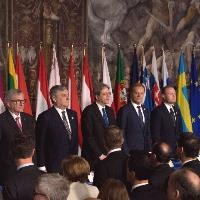(ROME) – Europe’s leaders meeting in Rome Saturday for the 60th anniversary of the Rome Treaties, renewed their commitment to the European Union, signing a new Rome Declaration pledging to work for unity at 27.
The anniversary celebrations included a number of events to mark the occasion and to reflect on Europe’s common future following the Brexit referendum. They followed the Commission’s launch on 1 March of a pan-European debate with a White Paper on the Future of Europe, meant to help citizens and leaders shape a new vision for the EU at 27 Member States. The White Paper set out possible scenarios for the future of Europe.
“Today in Rome we are renewing the unique alliance of free nations that was initiated 60 years ago by our great predecessors”, said EU Council President Donald Tusk at the ceremony in Campidoglio: “At that time they did not discuss multiple speeds, they did not devise exits, but despite all the tragic circumstances of the recent history, they placed all their faith in the unity of Europe.”
“Our parents and grandparents founded this Union with one common vision: never again war,” said the European Commission President Jean-Claude Juncker: “For 60 years, the values on which this Union is built have not changed: peace, freedom, tolerance, solidarity and the rule of law bind and unite us […] The European Union has changed our lives for the better. We must ensure it continues to do so for those that will follow us.”
At the end of the celebrations the leaders adopted and signed the Rome Declaration setting out a joint vision for the years to come.
In the Declaration, they stressed that the European Union is a unique Union with common institutions and strong values, a community of peace, freedom, democracy, human rights and the rule of law, a major economic power with unparalleled levels of social protection and welfare.
“European unity started as the dream of a few, it became the hope of the many. Then Europe became one again. Today, we are united and stronger: hundreds of millions of people across Europe benefit from living in an enlarged Union that has overcome the old divides.” – The Rome Declaration.
Leaders declared that, aware of the concerns of the EU citizens, they commit to the Rome Agenda, and pledged to work towards: a safe and secure Europe; a prosperous and sustainable Europe; a social Europe; a stronger Europe on the global scene.
The Treaties of Rome were the founding treaties establishing the European Economic Community (EEC) and the European Atomic Energy Community (EAEC), which were signed on 25 March 1957 and entered into force on 1 January 1958.
- Treaty establishing the European Economic Community
- Treaty establishing the European Atomic Energy Community (Euratom)
With institutional structures similar to that of the European Coal and Steel Community (ECSC), the new communities also comprised four institutions: a Commission, a Council and, shared jointly with the ECSC, an Assembly and a Court.
The first meeting of the Council of the EEC took place on 25 January 1958 under the chairmanship of Victor Larock, the Belgian Foreign Affairs Minister.
The White Paper presented by the European Commission on 1 March offers five scenarios for the Union’s evolution by 2025:
- “Carrying On”: the EU27 continues delivering on its positive reform agenda;
- “Nothing but the Single Market”: the EU27 would focus on the single market as 27 Member States are not able to find common ground on an increasing number of policy areas;
- “Those Who Want More Do More”: the EU27 proceeds as today but willing Member States could work closer together in specific areas;
- “Doing Less More Efficiently”: focus on delivering more and faster in selected policy areas, while doing less in others;
- “Doing Much More Together”: Member States decide to share more power, resources and decision-making across the board.
The Rome Declaration, 25/03/2017



